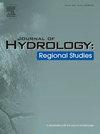Optimizing snow property forecasts over the tibetan plateau through hybrid assimilation of satellite precipitation and water vapor radiances using WRF model configured with Noah-MP
IF 4.7
2区 地球科学
Q1 WATER RESOURCES
引用次数: 0
Abstract
Study region
The Eastern region of the Qinghai-Tibet Plateau (EQTP)
Study focus
A regional numerical weather prediction and data assimilation system is constructed to investigate the impact of assimilating Global Precipitation Measurement (GPM) precipitation and Himawari-8/Advanced Himawari Imager (AHI) water vapor radiance using Weather Research and forecast (WRF) model and Four-dimensional variational assimilation (4Dvar) method on snow properties predictions. The predictions were compared with some reference datasets, including MODIS、VIIRS、GLDAS and ERA5-land.
New hydrological insights for the region
DA_G&A showed a significant increase in deep snow area (SD >15 cm), and a decrease in shallow snow area (SD<5 cm). Comparing with some reference datasets, the predictions exhibit good physical consistency between snow parameters and fine temporal-spatial resolution. The forecasts are found to be reliable and reasonable. However, Noah-MP coupled in WRF tends to overestimate SCF and SAL, which is largely attributed to the limitations of the associated parameterization schemes. These findings highlight the assimilation of atmospheric data can improve the forecasting of snow properties. However, in Noah-MP, there remains significant uncertainty in the snow-related parameterization schemes and initial conditions.
利用Noah-MP配置的WRF模式混合同化卫星降水和水汽辐射优化青藏高原雪性预报
研究区域青藏高原东部地区(EQTP)研究重点构建了区域数值天气预报和资料同化系统,利用天气研究与预报(WRF)模式和四维变分同化(4Dvar)方法,研究同化全球降水测量(GPM)降水和himawai -8/Advanced Himawari成像仪(AHI)水汽辐亮度对雪性预报的影响。将预测结果与MODIS、VIIRS、GLDAS和ERA5-land等参考数据集进行了比较。da_g&;A地区的新水文信息显示,深雪面积(sd>15 cm)显著增加,浅雪面积(SD<5 cm)显著减少。与部分参考数据集相比,预报结果具有较好的雪参数物理一致性和较好的时空分辨率。结果表明,预测结果可靠、合理。然而,在WRF中,Noah-MP耦合往往高估了SCF和SAL,这主要归因于相关参数化方案的局限性。这些发现强调了大气资料的同化可以改善雪特性的预测。然而,在Noah-MP中,与雪相关的参数化方案和初始条件仍然存在很大的不确定性。
本文章由计算机程序翻译,如有差异,请以英文原文为准。
求助全文
约1分钟内获得全文
求助全文
来源期刊

Journal of Hydrology-Regional Studies
Earth and Planetary Sciences-Earth and Planetary Sciences (miscellaneous)
CiteScore
6.70
自引率
8.50%
发文量
284
审稿时长
60 days
期刊介绍:
Journal of Hydrology: Regional Studies publishes original research papers enhancing the science of hydrology and aiming at region-specific problems, past and future conditions, analysis, review and solutions. The journal particularly welcomes research papers that deliver new insights into region-specific hydrological processes and responses to changing conditions, as well as contributions that incorporate interdisciplinarity and translational science.
 求助内容:
求助内容: 应助结果提醒方式:
应助结果提醒方式:


